Operation Ellamy
Operation Ellamy[11] was the codename for the United Kingdom participation in the 2011 military intervention in Libya.[12] The operation was part of an international coalition aimed at enforcing a Libyan no-fly zone in accordance with the United Nations Security Council Resolution 1973 which stipulated that "all necessary measures" shall be taken to protect civilians.[13] The coalition operation was designated by NATO as Operation Unified Protector, by the US as Operation Odyssey Dawn.[14][15] The Canadian participation as Operation Mobile[16] and the French participation as Opération Harmattan.[17] It was confirmed in December 2011 that the cost of the operations was £212m – less than was estimated, including £67m for replacing spent munitions, is all expected to be met from the Treasury reserve.[18]
| Operation Ellamy | |||||||
|---|---|---|---|---|---|---|---|
| Part of 2011 military intervention in Libya | |||||||
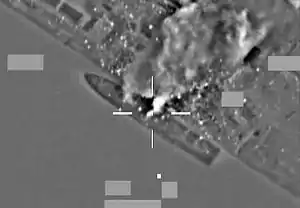 RAF Tornado GR4 attacks a warship in Al Khums naval base, 20 May 2011 | |||||||
| |||||||
| Belligerents | |||||||
|
|
| ||||||
| Commanders and leaders | |||||||
|
|
(De facto Commander-in-Chief) (Minister of Defence) (Khamis Brigade Commander) (Air Force Commander) | ||||||
| Strength | |||||||
|
1 helicopter carrier 2 destroyers 3 frigates 2 mine hunters 2 submarines 10 multirole fighters 16 strike fighters 3 AWACS 1 signals intelligence plane 4 attack helicopters | unknown | ||||||
| Casualties and losses | |||||||
| 1 killed (1 traffic accident in Italy)[3][4][5][6] |
200 tanks, armoured vehicles, artillery pieces, & SAMs destroyed[7][8] (until 12 April) 1 corvette destroyed 1 corvette damaged | ||||||
|
Unknown civilian casualties, Libyan state media claimed 48 civilians killed and 150 wounded by the overall UN operations[9] 40 civilians killed (in Tripoli; Vatican claim)[10] | |||||||
The no-fly zone was proposed during the Libyan Civil War to prevent government forces loyal to Muammar Gaddafi from carrying out air attacks on anti-Gaddafi forces. Several countries prepared to take immediate military action at a conference in Paris on 19 March 2011.[19]
The randomly generated codename, "Ellamy," is an alternative spelling of the Early Modern English word, Elami (E-la-mi), a musical solmisation designating the note E in the context of a tetrachord.[20] The spelling "Ellamy" is found in a poem frequently attributed to John Skelton, "The Harmony of Birds".
Background to operation
The UN Security Council Resolution 1973 passed on the evening of 17 March 2011 gave a mandate to countries wishing to enforce a no-fly zone over Libya militarily. A conference involving international leaders took place in Paris on the afternoon of Saturday 19 March 2011.[21] International military action commenced after the conference finished, with French military fighter jets being the first to participate in the operation only a few hours after the conference finished in Paris with the first shot fired at 1645 GMT against a Libyan tank.[22]
Deployed forces
- Royal Navy[2]
- HMS York (D98), a Type 42 destroyer
- HMS Cumberland, a Type 22 frigate[23][lower-alpha 1]
- HMS Sutherland, a Type 23 frigate[24]
- HMS Iron Duke, a Type 23 frigate
- HMS Triumph, a Trafalgar-class submarine[25]
- HMS Turbulent, a Trafalgar-class submarine[26]
- HMS Liverpool, a Type 42 destroyer[27]
- HMS Bangor, Sandown-class minehunter in a maritime surveillance role[26]
- HMS Brocklesby (Hunt-class mine countermeasures vessel)[28]
- HMS Ocean
- 2 x Lynx Mk 7 from Joint Helicopter Command
- 2 x Sea King Mk 4 from Joint Helicopter Command
- 1 x Lynx Mk 8 from 815 Naval Air Squadron
- 2 x Sea King Mk 7 from 857 Naval Air Squadron
- Royal Air Force
- Joint Force Air Component Headquarters at RAF Akrotiri
- Headquarters 906 Expeditionary Air Wing at Gioia del Colle Air Base[12]
- 10 × Typhoon multirole fighters from RAF Coningsby and RAF Leuchars,[19]
- 16 × Tornado GR4 interdictor/strike aircraft from RAF Marham[2][29]
- Headquarters 907 Expeditionary Air Wing at RAF Akrotiri[12]
- 3 × Sentry AEW.1 AWACS aircraft from RAF Waddington[30]
- 1 x Nimrod R1 signals intelligence aircraft[31][lower-alpha 2]
- 1 x Sentinel R1 airborne standoff radar aircraft from RAF Waddington[12]
- 2 × VC10 air-to-air refuelling tankers from RAF Brize Norton[32]
- Force Elements Operated from UK
- Tornado GR4 interdictor/strike aircraft from RAF Marham[2]
- TriStar K1 & KC1 air-to-air refuelling tankers from RAF Brize Norton[12]
- British Army
- 4 x Apache AH1 (on board HMS Ocean).
- 7 Signal Regiment Detachment
- 22 Signal Regiment Detachment
- Elements of United Kingdom Special Forces[33]
Summary of operation
- Day 1 – 19 March 2011
On the afternoon of the 19 March, the Royal Navy Trafalgar-class submarine HMS Triumph fired Tomahawk cruise missiles.[34] Alongside the US a reported combined total of 110 cruise missiles were fired during the first day of operations.[35]
The Royal Navy also had a Type 22 frigate (HMS Cumberland) and a Type 23 frigate (HMS Westminster) engaged in a naval blockade.
David Cameron, Prime Minister of the United Kingdom, confirmed that British aircraft were in action over Libya on the 19 March,[36] although it was the French Air Force who made the first coalition aerial presence over Libya earlier the same day.
E3D Sentry, Sentinel and VC-10 aircraft were said to be carrying out operations from RAF Akrotiri in Cyprus.[2]
On the night of the 19–20 March 2011, Storm Shadow missiles were launched by Tornado GR4 aircraft[37] of No. 9 Squadron from RAF Marham, flying 3,000 mi (4,800 km) against targets in Libya. They required refuelling by British air to air refuelling aircraft three times en route to their targets and once on their return.[38]
- Day 2 – 20 March 2011
The Ministry of Defence (MoD) announced that Tornado and Typhoon fighters would be deployed to Italy at Gioia del Colle Air Base.[2]
Meanwhile, the submarine HMS Triumph launched further Tomahawk cruise missiles at targets in Libya.[2]
Tornados GR4s, flying from RAF Marham, aborted their mission, due to information being received, that suggested civilians were in the target areas. The Tornado aircraft returned to RAF Marham fully armed.[39]
- Day 3 – 21 March 2011
The Prime Minister announced to the House of Commons on the 21 March at the start of a debate on the United Nations Security Council resolution that RAF Typhoons had been deployed to an Italian airbase (Gioia del Colle) and would fly in support of the No-Fly Zone.[40] Three Typhoons successfully conducted a mission and returned to Gioia del Colle.[41]
906 Expeditionary Air Wing formed at Gioia del Colle Air Base and were responsible for assets forward deployed there. 907 Expeditionary Air Wing formed at RAF Akrotiri responsible for assets forward deployed there. C-17A Globemaster and Hercules transport aircraft were also used to assist in the buildup of deployed forces.[12]
- Day 4 – 22 March 2011
RAF Typhoons flew their first ever combat mission,[42] patrolling the no-fly zone while Tornado GR4s from RAF Marham flew an armed reconnaissance mission. The MoD reported that Royal Navy ships Triumph, Westminister and Cumberland remained in theatre for additional strikes and maritime patrol.[43]
- Day 5 – 23 March 2011
Tornado GR4s forward deployed to Gioia del Colle Air Base.[8] In a media interview, the UK Air Component Commander, Air Vice-Marshal Greg Bagwell, stated that the Libyan Air Force "no longer exists as a fighting force" and that "we have the Libyan ground forces under constant observation and we attack them whenever they threaten civilians or attack population centres."[44]
- Day 6 – 24 March 2011
HMS Triumph fired Tomahawk cruise missiles at targets in Libya.[45] RAF Tornado aircraft on an armed reconnaissance mission fired Brimstone missiles against Libyan armoured vehicles that were reported to be threatening the civilian population of Ajdabiya. Four T-72 tanks were destroyed in the attack by RAF Tornados, and three by another coalition aircraft. Likely target locations had previously been identified by other Tornado aircraft equipped with RAPTOR pods.[29]
- Day 7 – 25 March 2011
RAF Tornado aircraft carried out Brimstone missile strikes, destroying three armoured vehicles in Misrata and two further armoured vehicles in Ajdabiya.[46]
- Day 9 – 27 March 2011
RAF Tornados from Gioia del Colle launched numerous armed reconnaissance missions, during the course of which ordnance released hit a total of 22 tanks, armoured vehicles and artillery pieces in the vicinity of Ajdabiya and Misrata.[47]
- Day 10 – 28 March 2011
Tornados from RAF Marham, supported by Tristar tanker aircraft from RAF Brize Norton, carried out Storm Shadow strikes against ammunition bunkers in the Sabha area in the southern Libyan desert. The bunkers were reportedly used to resupply Libyan Government troops attacking civilians in the north of the country.[47]
The Type 42 destroyer HMS Liverpool was deployed to the Mediterranean to relieve the Type 22 frigate Cumberland.[48]
- Day 11 – 29 March 2011
The London Conference on Libya was chaired by the Foreign Secretary, William Hague.
Two RAF Tornados flying from Gioia del Colle engaged a Libyan armoured fighting vehicle and two artillery pieces with Brimstone missiles near Misrata.[49]
- Day 12 – 30 March 2011
RAF Tornados flying from Gioia del Colle engaged three Libyan tanks, two armoured fighting vehicles and a surface-to-air missile site with Brimstone missiles and Paveway IV bombs in the vicinity of Misrata.[50] HMS Liverpool was deployed to relieve HMS Cumberland.[27]
- Day 13 – 31 March 2011
From 06:00 GMT, NATO took sole command of air operations over Libya under Operation Unified Protector, taking over from US Africa Command.[51][52][53]
- Day 15 – 2 April 2011
HMS Triumph returned to base HMNB Devonport flying the Jolly Roger marking six successful Tomahawk launches.[54]
RAF Tornado aircraft launched Paveway IV bombs against pro-Gaddafi forces. Two main battle tanks in Sirte and several small ground-attack aircraft at an airfield near Misrata were reportedly hit.[55]
- Day 16 – 3 April 2011
RAF Tornados reportedly launched successful attacks with Paveway IV and Brimstone missiles against ten armoured fighting vehicles south of Sirte.[55]
- Day 17 – 4 April 2011
The number of Tornado aircraft taking part in Operation Ellamy was increased from eight to twelve on 4 April, with the aircraft deploying from RAF Marham.[56] RAF Tornados, engaged in two separate strikes in the Libyan city of Sirte, launched three Brimstone missiles which destroyed one main battle tank and two surface-to-air missile launchers.[55]
- Day 22 – 9 April 2011
Seven tanks were destroyed by RAF Tornado aircraft, two in Ajdabiya and five in Misrata, using Paveway IV bombs and Brimstone missiles.[57]
- Day 23 – 10 April 2011
The MoD reported that over the weekend of 22–23 April, of a total of 61 armoured vehicles and air defence assets destroyed by NATO, 21 were destroyed by RAF aircraft.[7]
- Day 25 – 12 April 2011
HMS Turbulent was declared available in theatre by the MoD for Tomahawk strikes should they be required.[7]
RAF Typhoon aircraft were used operationally in a ground attack role for the first time. A Typhoon destroyed two main battle tanks near Misrata with Paveway II whilst a Tornado destroyed the third with Paveway IV. In total, RAF aircraft destroyed eight main battle tanks on 12 April. From the start of Operation Ellamy up until 12 April, RAF aircraft had engaged over 100 main battle tanks, artillery pieces, armoured vehicles and SAMs.[7]
- Day 31–18 April 2011
RAF Tornados and Typhoons attacked a pair of multiple rocket launcher vehicles and a light artillery piece reportedly firing on Misrata, as well as a self-propelled gun and tank.[58]
HMS Triumph was reported by the MoD to have launched two salvoes of Tomahawk missiles against command and control facilities, alongside precision strikes by RAF Tornados, Typhoons and coalition aircraft.[58]
HMS Liverpool intercepted the vessel MV Setubal Express heading for Tripoli, conducting a boarding party search with Royal Marines and finding trucks potentially of use to the Gaddafi regime. The merchant vessel was ordered to divert to Salerno in Italy.[59]
- Day 32 – 19 April 2011
The Foreign Secretary announced that a British Military Liaison Advisory Team would to be sent to Benghazi to advise the NTC on how to improve their military organisational structures, communications and logistics.[60]
- Day 43 – 30 April 2011
HMS Brocklesby destroyed a buoyant mine containing over 100 kg (220 lb) of high explosive. Using her sonar and underwater mine disposal system, Seafox, the mine was destroyed 1 mile (1.6 km) from the entrance to Misrata harbour, making the waters safe for aid ships to enter.[61][62]
- Day 49 – 6 May 2011
RAF Tornados attacked a site south of Sirte based on analysis of intelligence by RAF Tactical Imagery Wing. 20 FROG-7 launchers and a significant number of Scud canisters were reported as either completely or partially destroyed. RAF aircraft also destroyed one tank and two armoured vehicles in the area of Misrata and one mobile rocket launcher south of Tripoli.[63]
- Day 55 – 12 May 2011
An RAF Typhoon was reported to have destroyed two Palmaria 155 mm howitzers near Sirte.[64]
While engaged in surveillance operations off the coast of the rebel-held Libyan city of Misrata, HMS Liverpool came under fire from a shore battery, making her the first Royal Navy warship to be deliberately targeted since the Falklands War.[65] HMS Liverpool had been tasked with other NATO warships, to intercept small, high-speed inflatable craft spotted approaching the port of Misrata, the type which had been used previously to lay mines in the entrance of the port. Libyan rocket artillery on the coast fired an inaccurate salvo of rockets at the ship. HMS Liverpool returned fire with her 4.5-inch main gun, silencing the shore battery, in the Royal Navy's first use of the weapon since the 2003 invasion of Iraq.[67]
- Day 59 – 16 May 2011
Royal Navy Tomahawk missiles reportedly fired from HMS Triumph, and Paveway IV bombs released by RAF Tornado aircraft were reported to have struck intelligence agency buildings and a training base used by Colonel Gaddafi's Executive Protection Force. RN and RAF attacks were reported to have damaged or destroyed over 300 targets since the start of Operation Ellamy.[64]
- Day 62 – 19/20 May 2011
RAF Tornado GR4s hit two Nanuchka-class corvettes in Al Khums naval base and destroyed a facility in the dockyard constructing fast inflatable boats which Libyan forces had reportedly used to mine Misrata and attack vessels in the area.[68]
- Day 63 – 20 May 2011
RAF aircraft destroyed five multiple rockets launchers around Tripoli.[69]
- Day 67 – 24 May 2011
RAF aircraft attacked four armoured vehicles deployed near the Libyan city of Zlitan. An RAF Tornado attacked a Libyan coastal radar station near Brega, which was destroyed with a dual-mode seeker Brimstone missile.[69]
- Day 68 – 25 May 2011
A vehicle depot at Tiji was attacked by a Typhoon FGR4 and a Tornado GR4 dropping four Enhanced Paveway II and five Paveway IV weapons between them.[69]
- Day 70 – 27 May 2011
HMS Ocean (detached from the Response Force Task Group COUGAR 11 deployment) deployed with a complement of four Apache helicopters to aid operations along with Sea King Mk7 ASaC helicopters which begin flying surveillance and reconnaissance sorties of Libyan coast, Misrata, Sirte, and Benghazi.[70][71]
- Day 77 – 3 June 2011
Five ships from The Response Force Task Group were temporarily deployed from COUGAR 11 (an RFTG ship, HMS Ocean, and her embarked Apache attack helicopters had been deployed days earlier) to supplement UK forces in Operation Ellamy.[72]
- Day 102 – 28 June 2011
HMS Liverpool used her main gun to fire warning shots at pro-Gaddafi maritime forces moving along Libya's Mediterranean coast just west of the city of Misrata, amid concerns a threat was posed to civilians due to recent repeated attempts to mine the harbour. After initially ignoring the first shell, a further three were fired and the vessels were forced to return to their port of departure.[73][74]
- Day 107 – 3 August 2011
Several rockets were fired at HMS Liverpool. She returned fire with her 4.5-inch main gun. The attack came after the ship had fired a barrage of illumination rounds in support of an air attack on the stronghold of Zliten.[75]
- Day 145 – 10 August 2011
RAF Tornados launched direct from RAF Marham in Norfolk to target command and control and air defence targets with Stormshadow cruise missiles.[76]
- Day 151 – 16 August 2011
Since the start of military operations on 19 March, Royal Air Force, Royal Navy, and Army Air Corps precision strikes were reported to have damaged or destroyed some 870 former regime targets.[77]
HMS Liverpool was involved in the most intense shore-bombardment of the war. Liverpool had been tasked by a patrol aircraft to fire illumination rounds over the city of Zlitan. While conducting this mission, Liverpool came under fire from a Loyalist shore-battery. Liverpool responded by firing three rounds from her 4.5 inch gun, silencing the battery. Later on the same day, a patrol aircraft spotted a large pro-Gaddafi vehicle convoy carrying weapons and ammunition. Liverpool fired 54 shells from her 4.5-inch gun at the convoy, destroying or severely damaging many of the vehicles. During the ensuing chaos on the ground, NATO aircraft destroyed the remainder of the convoy.
 Apache helicopter takes off from HMS Ocean during Operation Ellamy
Apache helicopter takes off from HMS Ocean during Operation Ellamy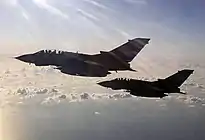 RAF Tornado GR4 aircraft during Operation Ellamy
RAF Tornado GR4 aircraft during Operation Ellamy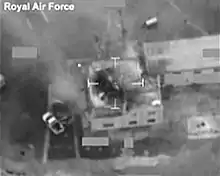 RAF Tornados destroying Libyan radar station
RAF Tornados destroying Libyan radar station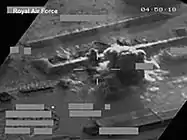 Tornado GR4 attack on Libyan SCUD launcher
Tornado GR4 attack on Libyan SCUD launcher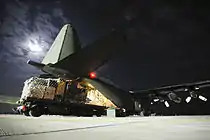 RAF C-130 Hercules delivers stores for Operation Ellamy
RAF C-130 Hercules delivers stores for Operation Ellamy
Notes
- HMS Cumberland was diverted to participate in operations off Libya en route back to the UK from her final deployment
- From Jane's Defence Weekly, 16 March 2011, operational requirements forced the Royal Air Force to deploy one of its two remaining Nimrod R1s two weeks before they were due to be withdrawn.
References
- Cohen, Tom (20 March 2011). "Mullen: No-fly zone effectively in place in Libya". CNN. Retrieved 20 March 2011.
- "Libya update". Ministry of Defence. 20 March 2011.
- "Airman killed in road accident in Italy". Ministry of Defence. 21 July 2011. Archived from the original on 25 July 2011. Retrieved 10 October 2019.
- "UK Airman Dies in Italy Road Accident". time.com. Archived from the original on 22 July 2011. Retrieved 24 July 2011.
- "Спецназ войск НАТО активно действует в Дамаске и Алеппо - Военный Обозреватель" [NATO Special Forces active in Damascus and Aleppo]. warsonline.info (in Russian). 28 August 2012. Retrieved 10 October 2019.
- Grigoriev, Alexander (6 September 2011). "Дорогой британский спецназ возвращается домой. Потери в Ливии признаны 'неприемлемыми'" [Dear British special forces returns home. Losses declared "unacceptable"]. argumentiru.com (in Russian). Retrieved 10 October 2019.
- "Typhoon joins Tornado in Libya Ground Attack Operations". Ministry of Defence. 13 April 2011. Retrieved 13 April 2011.
- "Libyan air force neutered". Ministry of Defence. 24 March 2011. Retrieved 24 March 2011.
- "Gaddafi denounces foreign intervention". Al Jazeera English. 20 March 2011. Retrieved 20 March 2011.
- "Vatican: Airstrikes killed 40 civilians in Tripoli". 31 March 2011. Retrieved 31 March 2011.
- "LIBYA: Operation ELLAMY: Questions and Answers". Ministry of Defence.
- "Coalition operations in Libya to continue". Ministry of Defence. 21 March 2010.
- "Security Council authorizes 'all necessary measures' to protect civilians in Libya". United Nations. un.org. 17 March 2011. Retrieved 20 March 2011.
- "DOD News Briefing by Vice Adm. Gortney on Operation Odyssey Dawn". U.S. Department of Defense. 19 March 2011.
- Rawnsley, Adam (21 March 2011). "What's in a Name? 'Odyssey Dawn' Is Pentagon-Crafted Nonsense". Wired. ISSN 1059-1028. Retrieved 10 October 2019.
- "Operation MOBILE: National Defence and Canadian Forces Response to the Situation in Libya". forces.gc.ca. 13 January 2012. Archived from the original on 15 June 2013. Retrieved 10 October 2019.
- "Libya : French air operations begin". defense.gouv.fr. 25 March 2011. Retrieved 10 October 2019.
- "Hammond says UK not seeking 'perfect Afghanistan'". BBC News. 8 December 2011.
- Judd, Terri (19 March 2011). "Operation Ellamy: Designed to strike from air and sea". The Independent. London. Retrieved 20 March 2011.
- Bradley, Henry; Craigie, William A.; Murray, James Augustus Henry (1891). "Elami". A New English Dictionary on Historical Principles. 3. Oxford: Clarendon. p. 68.
- "David Cameron meets allies for Libya crisis talks". BBC News. 19 March 2011. Retrieved 20 March 2011.
- "Libya: French plane fires on military vehicle". BBC News. 19 March 2011. Retrieved 20 March 2011.
- "HMS Cumberland deploys to Libya coast". Ministry of Defence. 23 February 2011.
- "Libya: French jets resume sorties as coalition builds". BBC News. 20 March 2011.
- "Libya: RAF 'comfortable' with outcome of airstrikes". BBC News. 20 March 2011.
- "Typhoon joins Tornado in Libya ground attack operations". Ministry of Defence. 13 April 2011.
- Powell, Michael (30 March 2011). "Captain's pride as HMS Liverpool sails for Libya". The Portsmouth News. Retrieved 10 October 2019.
- "Libya: RAF Tornados destroy seven Libyan tanks". BBC News. 9 April 2011. Archived from the original on 9 April 2011. Retrieved 9 April 2011.
- "Operational Update on Libya – 25 March". Ministry of Defence. 25 March 2011. Retrieved 25 March 2011.
- "Coalition Against Gadhafi Growing". Defense News. 20 March 2011. Archived from the original on 21 March 2011. Retrieved 21 March 2011.
- "UK military to be stretched by long Libya campaign". Reuters. 19 March 2011.
- "VC10 and TriStar Support Operations". Royal Air Force. 20 March 2011. Archived from the original on 21 March 2011. Retrieved 21 March 2011.
- Harding, Thomas (24 August 2011). "Libya: SAS leads hunt for Gaddafi". The Daily Telegraph. London.
- "British Armed Forces launch strike against Libyan Air Defence systems". Ministry of Defence. 19 March 2011. Archived from the original on 6 October 2012. Retrieved 19 March 2011.
- Al-Shalchi, Hadeel (20 March 2011). "US fires 110 missiles as no-fly zone is enforced". Irish Independent. Retrieved 20 March 2011.
- "Libya: Coalition launches attacks from air and sea". BBC News. 19 March 2011. Retrieved 19 March 2011.
- "British jets fired on Libyan targets". monstersandcritics.com. Deutsche Press Agentur. 20 March 2011. Archived from the original on 25 May 2012.
- "TARGET LIBYA: RAF reveals Marham jets' 3,000-mile mission, as aircraft prepare to deploy to Italy", edp24.co.uk, 20 March 2011
- "Updated: Second UK strike against Libyan defence assets". Ministry of Defence. 21 March 2011.
- David Cameron, Prime Minister (21 March 2011). "United Nations Security Council Resolution 1973". Parliamentary Debates (Hansard). United Kingdom: House of Commons. col. 700–701.
- "Live: Libya crisis". BBC News. 22 March 2011. Retrieved 22 March 2011.
- "RAF Typhoons patrol Libyan no-fly zone". Ministry of Defence. 22 March 2011.
- "Operations in Libya having a very real effect". Ministry of Defence. 22 March 2011.
- "Libya air force 'unable to fight'". BBC News. 23 March 2011. Retrieved 23 March 2011.
- "British submarine launches further strikes on Libyan air defence systems". Ministry of Defence. 24 March 2011. Retrieved 24 March 2011.
- "Brimstone Missiles Destroy Armoured Vehicles in Libya". Ministry of Defence. 26 March 2011. Retrieved 27 March 2011.
- "RAF Strikes Further Targets in Libya". Ministry of Defence. 28 March 2011. Retrieved 28 March 2011.
- Powell, Michael (29 March 2011). "Libya mission for Portsmouth based HMS Liverpool". The Portsmouth News. Retrieved 10 October 2019.
- "Libya Conference Participants Committed to Military Action". Ministry of Defence. 30 March 2011. Retrieved 31 March 2011.
- "RAF and Navy Patrol LIbyan Skies and Seas". Ministry of Defence. 31 March 2011. Retrieved 31 March 2011.
- "NATO Press Briefing". NATO. 31 March 2011.
- "US Navy P-3C, USAF A-10 and USS Barry Engage Libyan Vessels". Navy.mil. Retrieved 10 October 2019.
- "NATO Assumes Command of Libya Operations". Department of Defense. 31 March 2011.
- "HMS Triumph Returns from Libya Operations". Ministry of Defence. 4 April 2011. Retrieved 13 April 2011.
- "PM Visits RAF Crews Deployed on Operations". Ministry of Defence. 5 April 2011. Retrieved 5 April 2011.
- Wintour, Patrick (4 April 2011). "Libya: UK to increase number of Tornado jets". London: The Guardian. Archived from the original on 4 April 2011. Retrieved 4 April 2011.
- "Libya: RAF Tornados destroy seven Libyan tanks". BBC News Online. 9 April 2011. Archived from the original on 9 April 2011. Retrieved 9 April 2011.
- "UK military liaison advisory team to be sent to Libya". Ministry of Defence. 19 April 2011. Retrieved 19 April 2011.
- "Liverpool intercepts suspect ship bound for Libya". navynews.co.uk. 18 April 2011. Archived from the original on 29 April 2011. Retrieved 10 October 2019.
- "UK military liaison advisory team to be sent to Libya". Ministry of Defence. 19 April 2011. Retrieved 20 April 2011.
- "Royal Navy Destroys Libya Harbour Mine". Ministry of Defence. 5 May 2011. Retrieved 9 May 2011.
- HMS Brocklesby conducting MCM operations, 17 May 2011 – via www.youtube.com
- "RAF Destroys Gaddafi Rocket Launchers". Ministry of Defence. 9 May 2011. Retrieved 9 May 2011.
- "RAF and Navy Strike Targets in Tripoli". Ministry of Defence. 17 May 2011. Retrieved 17 May 2011.
- "Reporting from the Fleet". Navy News. 7 November 2011. Archived from the original on 6 June 2014. Retrieved 10 October 2019.
- "Cameron invites Libya rebels to open office in UK". BBC News. 12 May 2011.
- "RAF Strikes Gaddafi's Navy". Ministry of Defence. 20 May 2011. Retrieved 29 May 2011.
- "RAF Destroys Military Vehicle Depot in Libya". Ministry of Defence. 26 May 2011. Retrieved 29 May 2011.
- "Apaches get ready to help protect Libyan civilians". GOV.UK. 27 May 2011. Retrieved 10 October 2019.
- "Ocean and her gunships dispatched to Libya". Navy News. Archived from the original on 1 February 2016.
- "Task Force Sent to Libya to Ratchet Up the Pressure on Gaddafi". Navy News. Archived from the original on 4 June 2011. Retrieved 3 June 2011.
- "Warship fires on Gaddafi forces". The }ortsmouth News. 28 June 2011. Retrieved 10 October 2019.
- "Liverpools Show of Force Drives Back Gaddafis Gunboats". Navy News.
- Harding, Thomas (4 August 2011). "Libya: Royal Navy warship HMS Liverpool comes under heavy fire". telegraph.co.uk. ISSN 0307-1235. Retrieved 10 October 2019.
- "Long Range Libya Mission". raf.mod.uk. 15 August 2011. Archived from the original on 12 October 2011. Retrieved 10 October 2019.
- "Aircraft Strikes". raf.mod.uk. 11 August 2011. Archived from the original on 12 October 2011. Retrieved 10 October 2019.